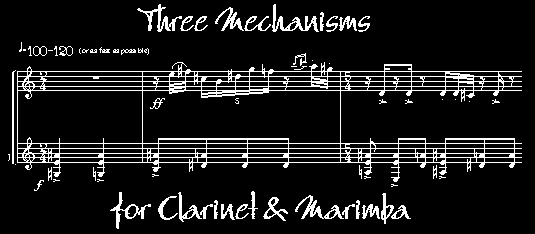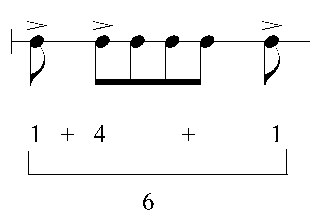
. . . is a piece that was composed over a period of a year & a half. I composed them out of order;
the second one coming first. These are indeed three
separate mechanisms; each of them having their own method of creation.
Some Technical Information on the Second Movement (if you are interested)
This second movement, was composed
using a mathematical system of the arrangement of the numerical sequence : 1 2 3 4 5 6 7
This sequence sounds pretty basic, but that is the beauty of it. I then take a modular formula
(found in "modular arithmetic") to obtain the numerical series that I want.
In modular arithmetic, you are dealing with a circular formation of numbers.
& what you are thinking right now IS : "What the HELL is this guy talking about? Right?"
Well, everyday, human beings whom live with time, deal with modular arithmetic, & does not even
know they are doing it.
PROOF: Someone is asked to meet at an appointment in 3 hrs. & the time is now 10am.
Now in normal math 10 + 3 is 13, BUT in modular arithmetic,
the answer is 1(if of course you are NOT in the military). SEE!!!
So the formula I used is as follows :
x-1-1(mod7) x-2-1(mod7) x-3-1(mod7) x-4-1(mod7) x-5-1(mod7) x-6-1(mod7) x-7-1(mod7)
**but in order to obtain the next "x" term, you must add "x" to itself. Sounds complicated, but it's not.**
I'll give you a start on the numeric sequence that this formula gives with the base sequence of 1 - 7.
First start with x=1
x-1-1(mod7) = 1-1-1 which equals 6 Then to obtain the next "x", add 6 to itself 6+6(mod7)=5
x-2-1(mod7) = 5-2-1 which equals 2 Then again add "x" to itself 2+2(mod7)=4
x-3-1(mod7) = 4-3-1 which equals 7
. . . . . . . etc . . . . . . . until it repeats after 21 times through. The first three are exemplified here.
Then when I finished with this, I broke the numbers into subgroups. Example is the first 6 : being turned into
1 + 4 + 1. Then assigned an eighth note to the number 1. So the first 6 in musical terms would be
eighth + 4eighths + eighth.

So there's the introduction of the process used for the Marimba part's rhythmic sequence.
If anyone is crazy enough to hear the rest or get any clarifications,
LET ME KNOW - "Contact ME"!!!
Duration of the Mechanisms:
I. 6.02'
II. 1.05'
III. 3.54'
